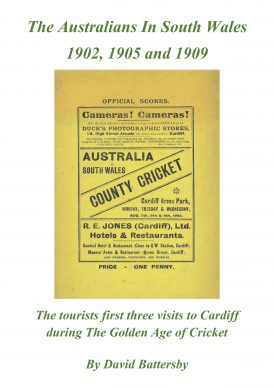The Australians In South Wales, 1902, 1905 and 1909
Martin Chandler |Published: 2022
Pages: 18
Author: Battersby, David
Publisher: Private
Rating: 3 stars

I was a very small boy in 1964, and have no actual memory of that summer’s Australian tourists. Despite that by the time the old enemy returned in 1968 my knowledge of cricket history was such that I knew their predecessors had won the Test series 1-0. I also realised by then that it was unusual for county teams to beat Australia, and that in 1964 Glamorgan had.
The 1968 Ashes was, courtesy of the efforts of Basil D’Oliveira and Derek Underwood in the fifth Test, drawn 1-1, so England did a little better than in 1964. I wondered at the time whether that victorious England team at the Oval drew any inspiration from the fact that lightning had struck twice in Wales, and that the 1968 Aussies had, once again, lost to Glamorgan. Those two performances certainly caught my imagination.
The much vaunted ‘Golden Age’ of cricket ended almost half a century before I was born, and before Glamorgan were granted First Class status in 1921, so it hadn’t really occurred to me, prior to reading David Battersby’s latest monograph, that there might be cricketing history between Australia and Wales dating back that far. I now know that there was.
In fact it turns out there were four matches scheduled to take place in South Wales before the Great War. Those were the three referenced in the title of the monograph, and then one in 1912, which Battersby explains in his introduction was, sadly, rained off without a ball bowled.
The monograph then goes to look at the three matches that were played, all at Cardiff Arms Park, with the first against a side styled as Glamorgan and Wiltshire, and the later two against South Wales CC. Interest in the matches was high with as many as ten thousand spectators keeping the Edwardian bean counters happy.
Over a century on the great benefit of that level of enthusiasm, as reflected in press attendance at the matches, is that there was plenty of contemporary coverage and, consequently, much interesting material from which Battersby can reconstruct the matches for a modern audience. The locals were beaten in 1902 and 1909, and would almost certainly have lost in 1905 as well had not rain had the last word but, given their status, the home sides put up creditable performances, particularly in 1902 when at one stage, having totalled 121 themselves, they had the tourists reeling at 48-7.
The narrative accounts of these little known fixtures are interesting enough, but I am sure author Battersby will not mind me making the observation that the real highlight of the monograph are the illustrations it contains, and particularly those of the three scorecards. Add to that a number of images of the Australian players from cigarette cards and postcards, all exceptionally well reproduced, and the reader has a most enjoyable means of whiling away a spare twenty minutes.
As with all Battersby monograph this one appears in a signed and numbered limited edition, this time of 85 copies, available £7 including UK postage and packing. Battersby’s email address is dave@talbot.force9.co.uk






Leave a comment